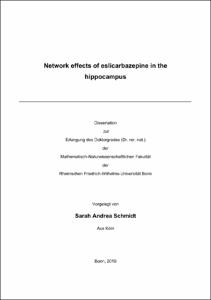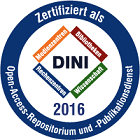Network effects of eslicarbazepine in the hippocampus

Network effects of eslicarbazepine in the hippocampus

| dc.contributor.advisor | Beck, Heinz | |
| dc.contributor.author | Schmidt, Sarah Andrea | |
| dc.date.accessioned | 2020-05-18T08:34:56Z | |
| dc.date.available | 2020-05-18T08:34:56Z | |
| dc.date.issued | 18.05.2020 | |
| dc.identifier.uri | https://hdl.handle.net/20.500.11811/8375 | |
| dc.description.abstract | Nearly 50 million people worldwide suffer from epilepsy, with 1/3 of the patients remaining without seizure control. This high number emphasizes the importance to develop new anti-epileptic drugs (AEDs) and to understand their mechanism. Many AEDs target voltage-gated sodium channels (VGSCs) in neurons of the brain, and the effects on a single cell basis is well studied. However, how AEDs act on the level of neuronal networks in the normal and epileptic brain is much less understood. Therefore, I investigated the effects of the new AED eslicarbazepine (S-Lic), the active metabolite of eslicarbazepine acetate on different types of excitatory and inhibitory neurons, as well as on feed-back and feed-forward inhibitory motifs in the CA1 area of the hippocampus. I performed my experiments in hippocampal slices from both sham-control and pilocarpine-treated chronically epileptic rats. I found that 300 μM S-Lic significantly reduces maximal firing rates in CA1 pyramidal cells, as well as in putative feed-forward interneurons located in the CA1 stratum radiatum and in putative feed-back interneurons located in stratum oriens of CA1. Consequently, S-Lic reduced feed-forward inhibition in both sham-control and epileptic animals. However, S-Lic did not reduce feed-back inhibition but resulted in a plastic upregulation of feed-back inhibitory postsynaptic currents (IPSCs) only in epileptic and not in sham-control animals. I showed that this plastic upregulation is dependent on Ca2+ permeable AMPA receptors (CP-AMPAR) and relies on an anti-Hebbian LTP mechanism. Indeed, this type of LTP has been described previously for inhibitory feed-back interneurons. In summary, my results show that S-Lic, in contrast to other AEDs, affects inhibitory circuits in the CA1 hippocampal region also in epileptic tissue. Therefore, AEDs mechanism of action may not be fully explained by direct actions on their target channels and on a single cell level. Additionally, it is necessary to investigate long-term effects of AEDs on microcircuits in the brain. | en |
| dc.language.iso | eng | |
| dc.rights | In Copyright | |
| dc.rights.uri | http://rightsstatements.org/vocab/InC/1.0/ | |
| dc.subject.ddc | 570 Biowissenschaften, Biologie | |
| dc.title | Network effects of eslicarbazepine in the hippocampus | |
| dc.type | Dissertation oder Habilitation | |
| dc.publisher.name | Universitäts- und Landesbibliothek Bonn | |
| dc.publisher.location | Bonn | |
| dc.rights.accessRights | openAccess | |
| dc.identifier.urn | https://nbn-resolving.org/urn:nbn:de:hbz:5-58548 | |
| ulbbn.pubtype | Erstveröffentlichung | |
| ulbbnediss.affiliation.name | Rheinische Friedrich-Wilhelms-Universität Bonn | |
| ulbbnediss.affiliation.location | Bonn | |
| ulbbnediss.thesis.level | Dissertation | |
| ulbbnediss.dissID | 5854 | |
| ulbbnediss.date.accepted | 08.05.2020 | |
| ulbbnediss.institute | Medizinische Fakultät / Institute : Institut für Experimentelle Epileptologie und Kognitionswissenschaften | |
| ulbbnediss.fakultaet | Mathematisch-Naturwissenschaftliche Fakultät | |
| dc.contributor.coReferee | Witke, Walter |
Files in this item
This item appears in the following Collection(s)
-
E-Dissertationen (4397)




